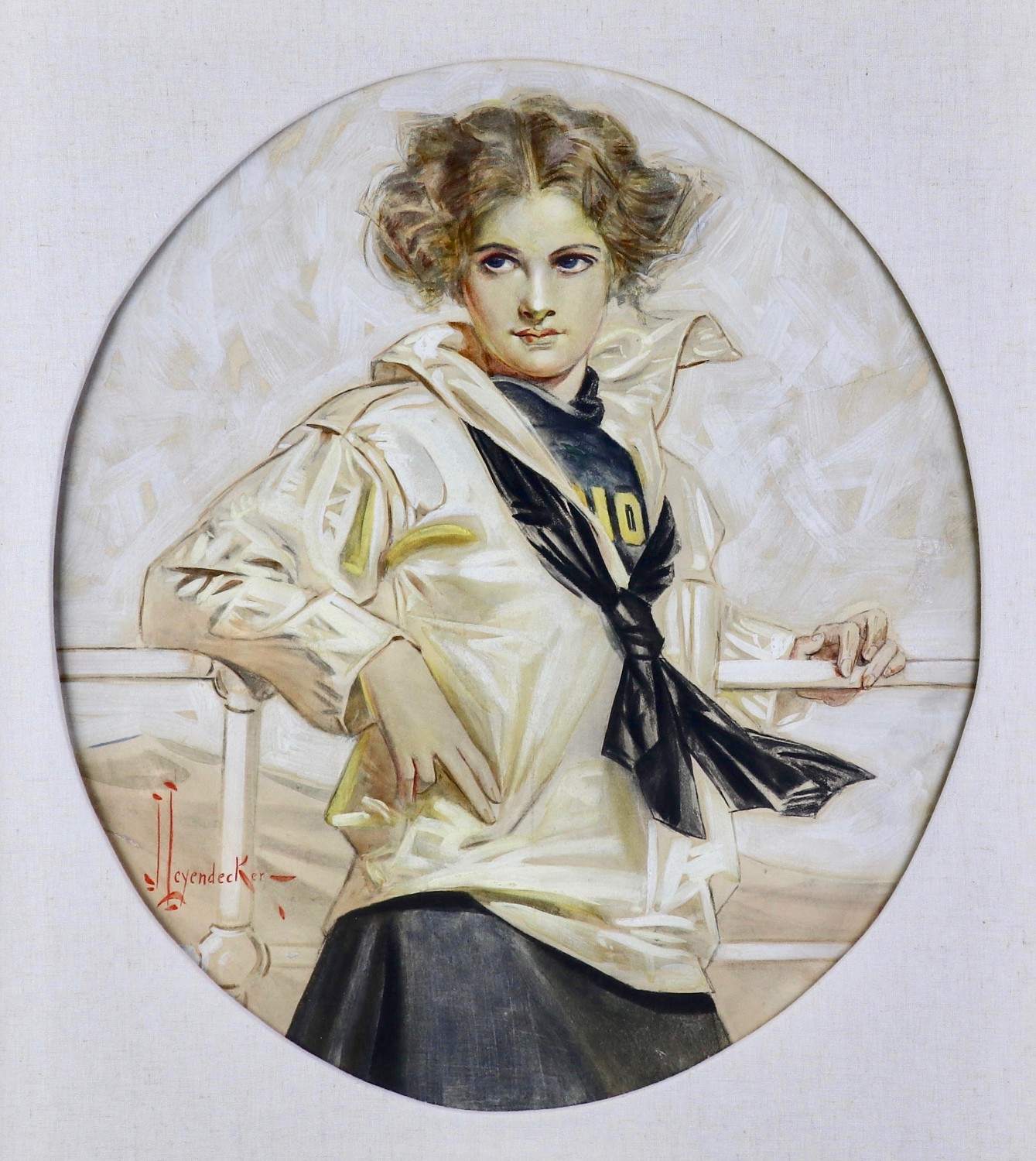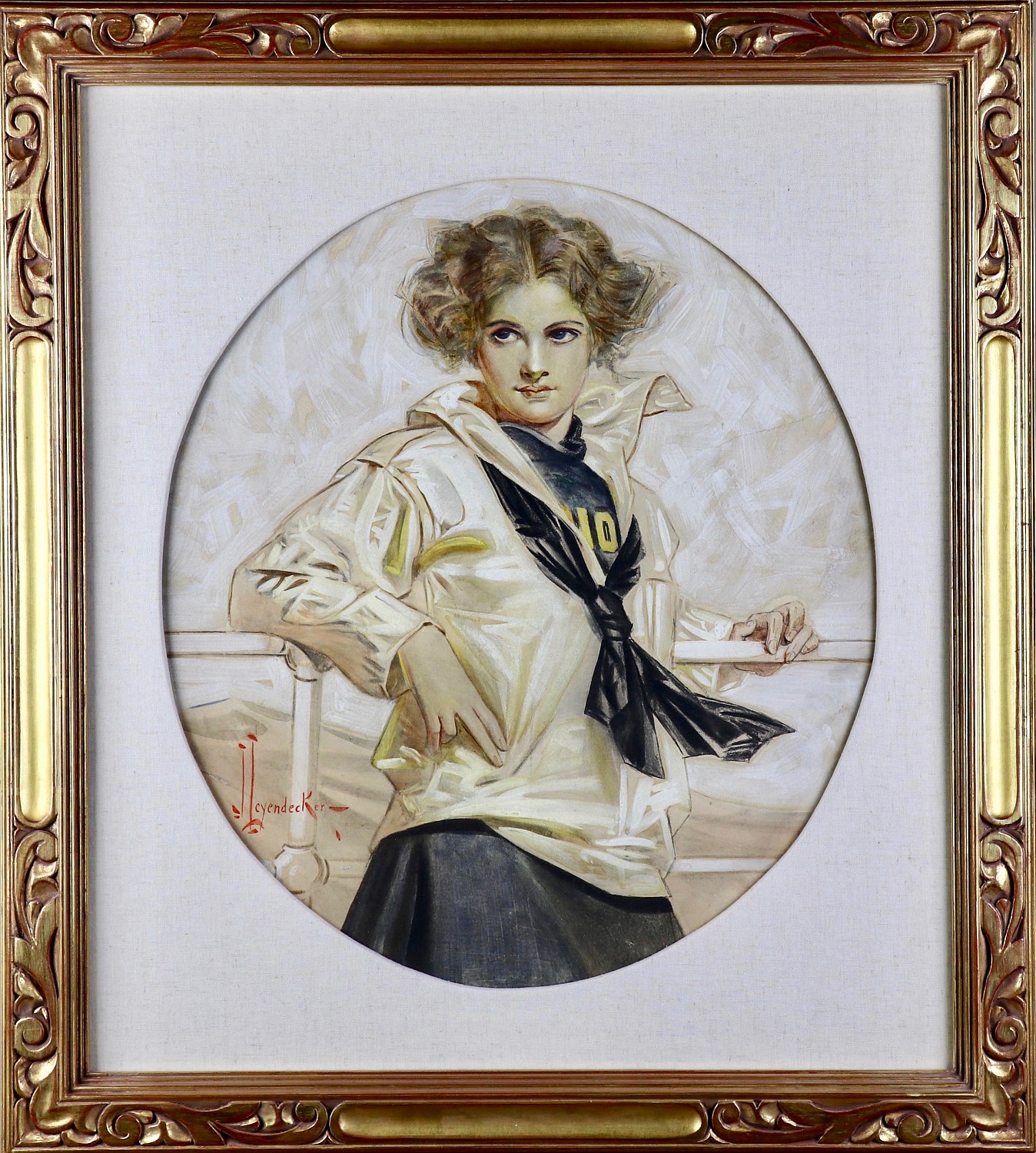"Lucky Bag Girl" Lot no. 3796
By Joseph Christian Leyendecker (1874-1951)
1910 (Estimated)
20.75" x 18.00"
Hand Painted Fine Print
Signed Lower Left
REQUEST PRICE
PURCHASE REQUEST
The Lucky Bag was the Yearbook for the United States Naval Academy - dedicated to the graduating classes at Annapolis. Interestingly, a Leyendecker illustration appeared the following year - in the 1911 Howitzer, the yearbook for the United States Corps of Cadets at West Point. After that initial Leyendecker illustration appearance in the Lucky Bag, illustrators regularly contributed materials to the annual Annapolis publication. In 1921, Howard Chandler Christy and Coles Phillips contributed works – followed by a Norman Rockwell inclusion.
Publication/Usage:
-Insert/Announcement Card in the 1910 Lucky Bag yearbook publication., VOL XVII
-Class of 1910 Graduation Announcement & Invitation
-Dance Card “Navy Girl” (song) re-dedicated to the Class of 1910. (for Graduation Ball)
-Full-page Reproduction in 1910 Army-Navy football game program, November 26, 1910.
Notation regarding Army-Navy Football game of 1910: The rivalry between Annapolis and West Point, while friendly, was always intense. There was no Army-Navy game in 1909. The Army cancelled their remaining schedule after the death of a player in the Harvard game. The Navy also suffered a loss of a midshipman during the same season when their quarterback, Earl Wilson, sustained a neck injury in the Villanova game and died. As a result, the scheduled Army-Navy game of 1910 was highly anticipated and received extra press attention. The Navy team captain had missed part of the 1910 season with typhoid fever and his appearance was questionable. Franklin Field, on the University of Pennsylvania campus, was full of excitement on that November 26th day in 1910 – and the attendance had swollen to 34,880 fans by kickoff time.
The Navy emerged victorious by a score of 3-0 and they finished the 1910 season undefeated. That year they outscored their opponents by 99-0, a feat that has never been equaled. Many game programs, all bearing this Leyendecker illustration of a beautiful coed, went home with excited fans that witnessed Navy’s record-breaking season.
Credit: Bud Moon
Explore related art collections: Portraits / Women as Subjects / $20,000 - $50,000
See all original artwork by Joseph Christian Leyendecker
ABOUT THE ARTIST
Joseph Christian Leyendecker was born in Montabaur, Germany, and came to America at the age of eight. Showing an early interest in painting, he got his first job at 16 in a Chicago engraving house on the strength of some larger pictures he had painted on kitchen oilcloth. In the evenings after work, he studied under Vanderpoel at the Chicago Art Institute, and saved for five years to be able to go to France and attend the Academie Julian in Paris.
Upon his return, as a thoroughly trained artist with immense technical facility, Leyendecker had no difficulty in obtaining top commissions for advertising illustrations and cover designs for the leading publications. His first Post cover was done in 1899, and he did well over 300 more during the next 40 years. Among the most famous of these was his annual New Years Baby series.
His advertising illustrations made his clients famous. The Arrow Collar Man was a byword for the debonair, handsome male, and women wrote thousands of love letters to him in care of Cluett Peabody & Company. His illustrations for Kuppenheimer Clothes were equally successful in promoting an image of suited elegance. He was elected to the Society of Illustrators Hall of Fame in 1977.A major retrospective exhibition of Leyendecker's work was mounted at the Norman Rockwell Museum in Stockbridge, Massachusetts, in 1997-98.
Joseph Christian Leyendecker was born in Montabaur, Germany, and came to America at the age of eight. Showing an early interest in painting, he got his first job at 16 in a Chicago engraving house on the strength of some larger pictures he had painted on kitchen oilcloth. In the evenings after work, he studied under Vanderpoel at the Chicago Art Institute, and saved for five years to be able to go to France and attend the Academie Julian in Paris.
Upon his return, as a thoroughly trained artist with immense technical facility, Leyendecker had no difficulty in obtaining top commissions for advertising illustrations and cover designs for the leading publications. His first Post cover was done in 1899, and he did well over 300 more during the next 40 years. Among the most famous of these was his annual New Years Baby series.
His advertising illustrations made his clients famous. The Arrow Collar Man was a byword for the debonair, handsome male, and women wrote thousands of love letters to him in care of Cluett Peabody & Company. His illustrations for Kuppenheimer Clothes were equally successful in promoting an image of suited elegance. He was elected to the Society of Illustrators Hall of Fame in 1977.A major retrospective exhibition of Leyendecker's work was mounted at the Norman Rockwell Museum in Stockbridge, Massachusetts, in 1997-98.
Kent Steine



